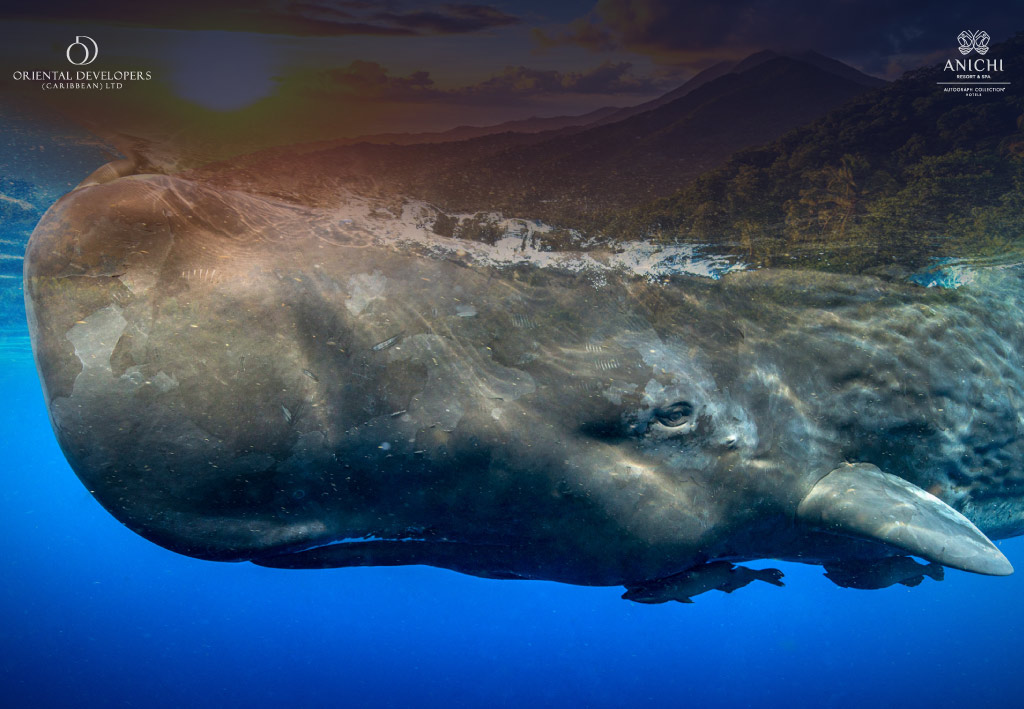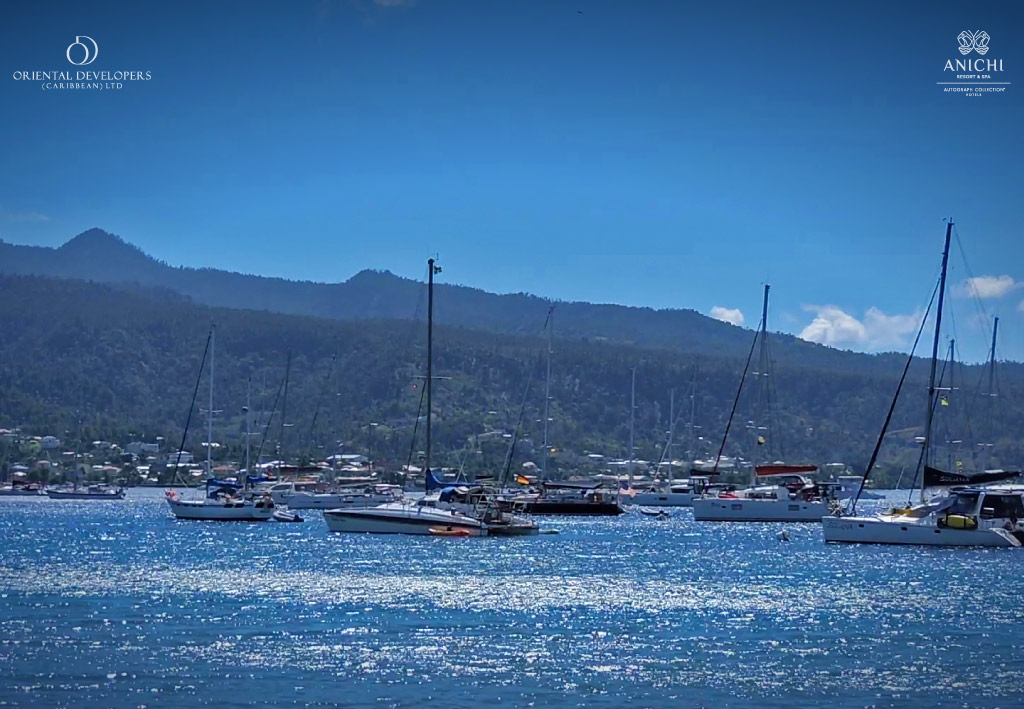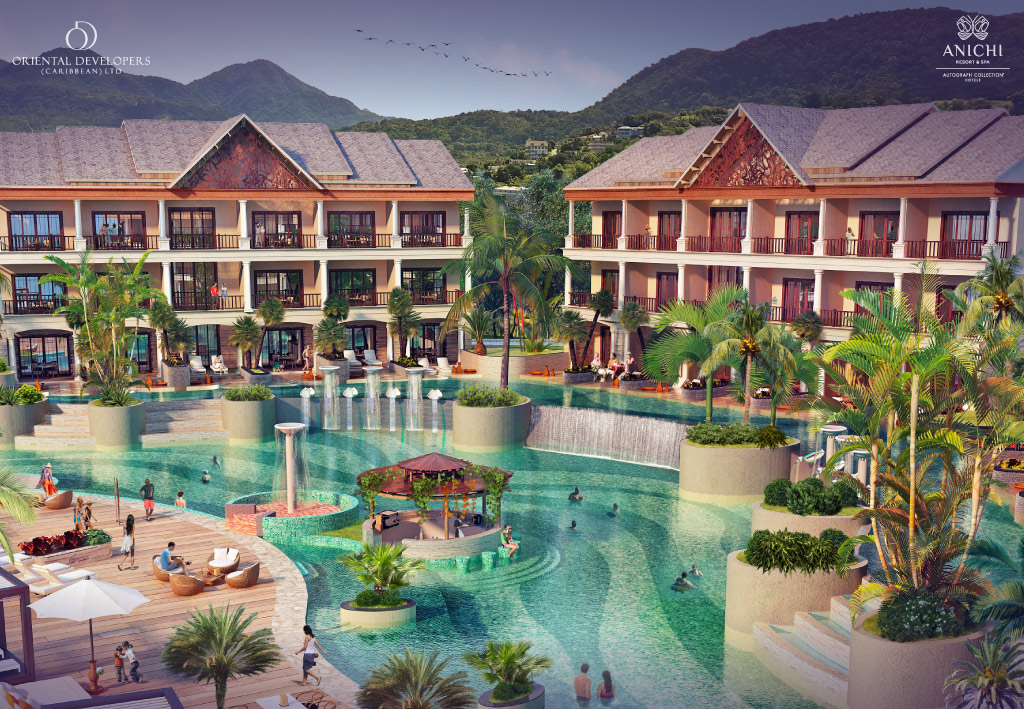

A moment of underwater stillness: a sperm whale off the coast of Dominica, where people and nature coexist in harmony.
Dominica continues to strengthen its international standing in marine tourism, leveraging its natural assets and a long-term ecological development strategy. For over 75 years, the country’s national policy has prioritised environmental protection and biodiversity conservation. This is enshrined in its legislation and reflected in the creation of marine reserves and climate-resilient infrastructure. Rather than following transient trends, Dominica pursues a carefully considered course that reinforces its global position.
A recent acknowledgement of its growing recognition came from Condé Nast Traveler on 14 May 2025, which listed Dominica among the world’s top snorkelling destinations. The publication highlighted the island’s exceptional combination of volcanic landscapes, crystal-clear coastal waters, and opportunities to observe rare marine mammals in their natural habitat.
Consistent attention from leading global media and tour operators to Dominica’s natural resources has not only heightened its appeal among travellers seeking authentic and restorative experiences. Increasingly, investors are viewing the island as a platform for citizenship investment and ecologically focused ventures.
Dominica is the only country in the world where sperm whales reside year-round, making it a uniquely positioned destination for marine tourism. More than 22 species of cetaceans have been recorded in its coastal waters, ranging from humpback and false killer whales to numerous types of dolphins. Particularly notable is the opportunity to observe sperm whales throughout the year — with females and calves remaining off Dominica’s shores permanently, while adult males return seasonally to mate.
The eastern beaches are vital nesting grounds for leatherback turtles, the largest living sea turtles, which can grow up to 2.5 metres long with a flipper span of five metres. Other rare species such as the hawksbill, loggerhead, and green turtles also inhabit the island’s pristine waters, enhancing Dominica’s appeal for diving and marine expeditions.
In 2024, Dominica announced the creation of the world’s first marine sanctuary dedicated exclusively to sperm whale habitat protection — a landmark move affirming the island’s leadership in sustainable tourism. Alongside this new sanctuary, the island maintains two protected marine areas: the Soufrière–Scotts Head Marine Reserve in the southwest, known for volcanic reefs, underwater thermal springs and sea turtle populations; and the marine zone of Cabrits National Park in the north, spanning roughly 350 hectares between Prince Rupert and Toucari Bays.
Protected areas play a vital role in preserving marine biodiversity and safeguarding ecosystems under increasing pressure from climate change and human activity. The expansion of a well-managed marine reserve network has increased Dominica’s protected waters by 70%, now covering approximately 3% of its exclusive economic zone — a key component of its national climate-resilient strategy.
International media regularly praise the richness of Dominica’s underwater world. The Huffington Post and National Geographic frequently rank the island among the top 10 global destinations for whale watching, while Condé Nast Traveler named it the best island in the Caribbean for diving. Its volcanic reefs, thermal springs, vibrant marine life and renowned dive sites — from Champagne Reef to the Soufrière–Scotts Head Marine Reserve — consistently attract professional divers and novice explorers alike.
Unlike many Caribbean destinations whose tourism strategies revolve around short-term demand for beach holidays, Dominica offers a more substantial model. Here, marine tourism is not an attraction but a multi-layered system that harmoniously integrates natural features, cultural heritage, and institutional governance.
In 2025, Dominica launched the region’s first dedicated sea kayaking route — the Waitukubuli Sea Trail, stretching approximately 60 kilometres along the west coast. This trail connects key ecosystems — from mangrove lagoons to volcanic cliffs — and passes through fishing villages that offer visitors a glimpse into traditional island life. Developed in partnership with local cooperatives and environmental groups, the trail forms part of a broader socio-economic landscape rather than simply a tourism product.
The integration of popular activities such as diving and whale watching into the island’s environmental agenda adds further depth. These flagship experiences are tightly regulated. One of the key sites remains Champagne Reef, a geothermal zone where warm fumaroles rise from the seabed, creating a rare combination of diving and thermal relaxation. Access to this natural wonder is limited by a quota system, with visits allowed only under the guidance of licensed professionals to protect sensitive marine habitats.

Yachts anchored in the turquoise waters off Dominica’s coast — a meeting point of unspoilt nature, sustainable tourism, and ocean exploration.
Yachting plays a significant role in diversifying Dominica’s marine tourism. Prince Rupert Bay and the harbour at Portsmouth serve as central hubs for international yachts. The Portsmouth Association of Yacht Services (PAYS) oversees moorings, security, and community engagement. Additional services are provided by Dominica Yacht Services and independent agencies, offering vessel support, maintenance, and provisioning.
Yachting infrastructure is closely linked with coastal ecology: many routes pass through marine parks and natural bays with regulated access. Coastal charters and tours combine comfortable navigation with environmental education.
Sport fishing is also growing, in coordination with conservation principles. Around twenty operators offer licensed tours — from shallow-water angling to deep-sea fishing for tuna, wahoo, and marlin. Professional guides are trained in catch-and-release techniques, and local restaurants prepare guests’ catch using traditional recipes, turning fishing into a rich culinary and tourist experience.
In the villages of Soufrière and Scotts Head, small-scale tourism initiatives are flourishing: boat excursions in traditional fishing vessels, culinary workshops, and educational programmes on marine ecology, including turtle conservation. While direct observation of turtle nesting mostly occurs along the eastern and northeastern coasts — such as at Rosalie Bay and La Plaine — the southwest provides a strong educational component and helps diversify the island’s tourism offering. Redirecting visitor flows to less frequented areas supports local development and eases pressure on key ecosystems.
Taken together, marine tourism in Dominica goes far beyond scenic beauty and becomes a tool for sustainable development — underpinned by carefully designed governance mechanisms that demonstrate how nature conservation and economic viability are not opposites, but mutually reinforcing.
Dominica’s commitment to sustainability is not merely declarative. For decades, the island has pursued a policy of environmentally responsible tourism, prioritising quality over volume and preserving its natural balance.
Particular emphasis is placed on marine area management. Protected zones are governed by strict regulations: operators must follow licensed protocols limiting speed, proximity to marine animals, and noise or physical impact. In the most sensitive areas — such as Champagne Reef and waters near sperm whale habitats — access is capped, pre-booking is required, and only accredited guides are permitted. In 2023, Dominica received an award from the Caribbean Tourism Organization for its WildDominique initiative launched in 2022 — a programme to train and certify guides as part of the national environmental education strategy.
This environmental focus also extends to infrastructure. New tourism developments are designed with energy efficiency, water management, and minimal disruption to the natural landscape in mind. Thanks to this development model, Dominica is considered a benchmark for sustainable tourism in the Caribbean.

Junior Suite – Resort Rendering of Anichi Resort & Spa.
Dominica’s Citizenship by Investment (CBI) Programme, one of the most transparent in the world, is integrated into its broader ecological development strategy. Investor funds are channelled into climate infrastructure, expansion of protected areas, and reinforcement of coastal ecosystems. In this way, investment directly supports the preservation of the island’s unique environment and the growth of its tourism economy.
Of particular interest is the opportunity to invest in coastal real estate, including properties near marine parks and natural landmarks. These projects not only meet international environmental standards but are also in steady demand among tourists and industry professionals.
One standout example is the Anichi Resort & Spa, certified to international sustainable construction standards. Situated close to Cabrits National Park, the resort was designed in harmony with the natural terrain and equipped with energy-efficient systems, water purification, and waste management solutions. The development boosts the north coast’s economy and exemplifies how CBI participation can be both sustainable and reputationally rewarding.
Thus, acquiring Dominican citizenship through investment is more than a change of personal status — it is a contribution to the green economy and support for a nation that has become a symbol of responsible tourism and environmental stewardship.
In a time of shifting global priorities, Dominica offers a rare combination: natural uniqueness, institutional stability, and a clear trajectory of sustainable growth. For those exploring investment alongside the opportunity to acquire citizenship, this translates into engagement with an economy of real, measurable, and growing value.
Dominica is not shaped by external trends — it sets its own course, exemplifying how development can align with environmental protection and long-term strategic thinking.